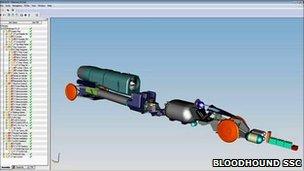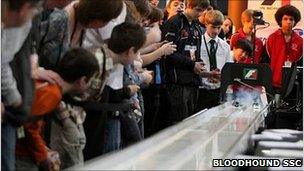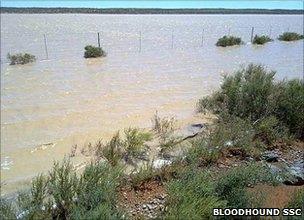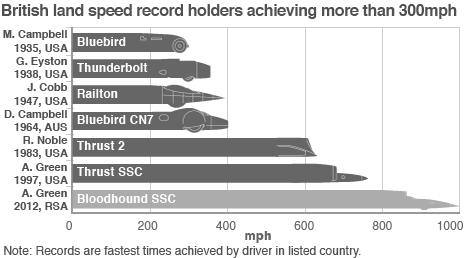Bloodhound diary: Stopping from 1,000mph
- Published
RAF fighter pilot Andy Green intends to get behind the wheel of a car that is capable of reaching 1,000mph (1,610km/h).
Powered by a rocket bolted to a Eurofighter-Typhoon jet engine, the Bloodhound car will mount an assault on the land speed record.
Wing Cmdr Green is writing a diary for the BBC News Website about his experiences working on the Bloodhound SSC (SuperSonic Car) project and the team's efforts to inspire national interest in science and engineering.
It's been another exciting month for Project Bloodhound, as we solve a few more of the problems on the way to 1,000mph.

Building a 1,000mph Car - don’t try this at home
We released another key part of the project to the public - the "Genome" of the Bloodhound SSC, external, in the form of engineering assembly drawings.
We're fairly sure that this is the first time in history that a team has released full drawings of a world-class race car before they've even built it, never mind raced it.
It's another powerful part of our education programme (has your local school signed up yet?), external and is aimed to give full access throughout the project.
With these drawings (and assuming you have a state of the art military jet engine and the world's largest hybrid rocket lying about), you could now set about building your own 1,000mph car - but our Chief Engineer, Mark Chapman, recommends that you don't.
The launch of the genome drawings, with the help of Bloodhound sponsors the Institution of Mechanical Engineers, was supported by parking our full-size show car in Horse Guards Parade in Central London - where it drew a lot of attention, as you can imagine, especially from our younger fans.

Look, Mum. It's a 1,000mph car
The education programme is a key part of Project Bloodhound and we are having a lot of success with the Bloodhound class in the "F1 in Schools" programme.
Needless to say, with its "unlimited" design, the Bloodhound class is about twice as fast as the F1 class, and the young car designers have to overcome aerodynamic and stability problems just the same as we do.
This global competition involves designing and racing precision-made balsawood cars, powered by compressed gas cylinders, along a 20m straight track. Wilmington Grammar School's "Speeding Snails" team recently set an incredible time of 0.620 seconds, at an average speed of 86mph.
Think you could do better? During the world famous Goodwood Festival of Speed at the start of July, we are planning to hold the Bloodhound Challenge. Come and have a go at setting your own world record!
We'll be joined at Goodwood again by STP and, for the first time, Cosworth, who are supplying the F1 engine that powers our rocket pump (yes, really).

F1 in schools - the Bloodhound class is very fast
We'll be testing the full rocket system, external in the UK, complete with the Cosworth F1 engine, in a couple of months' time. That's going to be an exciting event to watch. I can't wait.
The engineering design work continues at a furious pace. With the rear of the chassis already in manufacture, we are finalising the last bodywork details. This is to fix the "yaw static margin" - a measure of how directionally stable the car is.
We need to make sure that, just like a dart, the car's mass is far enough forwards, and the fin is large enough, to keep it "pointy-end forwards" (which I'm very keen on!).
In the next few weeks, we should be finished with this last key piece of the aerodynamics.
The challenge of setting a 1,000mph World Land Speed Record is not only a problem of going very fast - we also have to stop the car. During the first half of a run, more acceleration is optional, but once the car leaves the measured mile at 1,000 mph, slowing down has just become compulsory.

The same power as 100 F1 cars (101 if you include the Cosworth pump motor)
In addition to airbrakes (backed up by brake parachutes if necessary), Bloodhound SSC will also be fitted with wheel brakes for use below about 250 mph.
The brakes won't be used at 1,000 mph - but they will have to spin that quickly. We've just finished the first phase of brake disc tests, with some slightly disappointing results.
We tested two different disc types, based on material used by the F16 and Typhoon jet fighters.
The F16 discs both failed at around 800mph - no joy there. The Typhoon disc made it to over 11,000 rpm (equivalent to 1,100 mph) on the spin rig, but then also failed (with a very loud bang!), so we've got some more work to do to find the ideal disc.
Still, if this was easy, everyone would be doing it.
Of course, some other people are trying to do this - we've got some competition for the World Land Speed Record, external - and it's interesting to compare notes occasionally.

Hakskeen Pan in the Northern Cape – the world's best race track... when it's dry
While we are all planning on brake parachutes and airbrakes (the US North American Eagle team is using a converted jet fighter which came ready-fitted with them), we all have different solutions to the wheel brake problem.
The Eagle is using non-contact magnetic brakes, while the Australian Aussie Invader 5R is exploring a "Fred Flintstone" ground friction brake - we discounted this option last year, partly because we don't have the room to fit it under the car. It's going to be fascinating to see how they all work, when the racing begins.
The weather in South Africa is still keeping us guessing. The Northern Cape has seen one of the wettest rainy seasons that it's had for a long time.
As a result, Hakskeen Pan, external is still flooded, so we can't re-start the track preparation work for a few weeks yet.
Once the pan is dry, the Northern Cape team will continue with the clearance of an amazing 24 million sq m of surface, to produce the world's best race track for Bloodhound SSC.

- Published26 April 2011
- Published5 March 2011
- Published7 February 2011
- Published21 November 2010
- Published13 November 2010